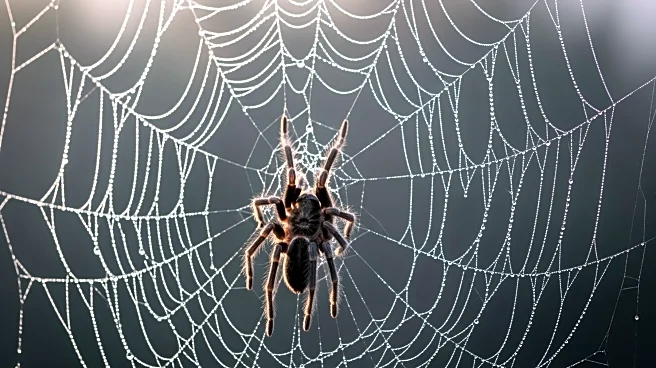What's Happening?
In the rugged mountains above Los Angeles, the tarantula mating season is in full swing, typically peaking in October. Male tarantulas leave their burrows in search of mates, a journey fraught with danger
as female tarantulas are known to consume their suitors. According to Rodrigo Monjaraz Ruedas, assistant curator of entomology at the Natural History Museum of L.A. County, males must be quick and cautious even after mating to avoid being eaten. The mating season, which runs from July to November, is triggered by autumn rains, prompting males to follow pheromones to females. This period offers the best chance to observe these arachnids, particularly in areas like the Angeles National Forest and Santa Monica Mountains.
Why It's Important?
The tarantula mating season highlights the complex and often perilous natural behaviors of wildlife in California. Understanding these patterns is crucial for conservation efforts and public awareness, especially as urbanization poses significant threats to these creatures. Male tarantulas face risks such as drowning in pools or being hit by vehicles during their mating quest. The presence of tarantulas in urban areas also raises awareness about the biodiversity within city limits and the need for coexistence with wildlife. This season serves as a reminder of the delicate balance between human development and natural habitats.
What's Next?
As the mating season continues, conservationists and wildlife enthusiasts may focus on educating the public about tarantulas and their ecological roles. Efforts to protect these spiders from urban hazards could be emphasized, potentially leading to initiatives that safeguard their natural habitats. The Natural History Museum's open-air spider pavilion, featuring tarantulas and other species, offers an educational opportunity for visitors to learn more about these creatures and their behaviors.
Beyond the Headlines
The tarantula mating season also sheds light on the broader ecological dynamics in California. With over 1,300 spider species in the state, including 10 tarantula species, the region's biodiversity is significant. The interactions between these species and their environments can offer insights into ecological health and the impacts of climate change. Additionally, the public's perception of spiders, often seen as fearsome, may shift towards appreciation and understanding through educational efforts.













